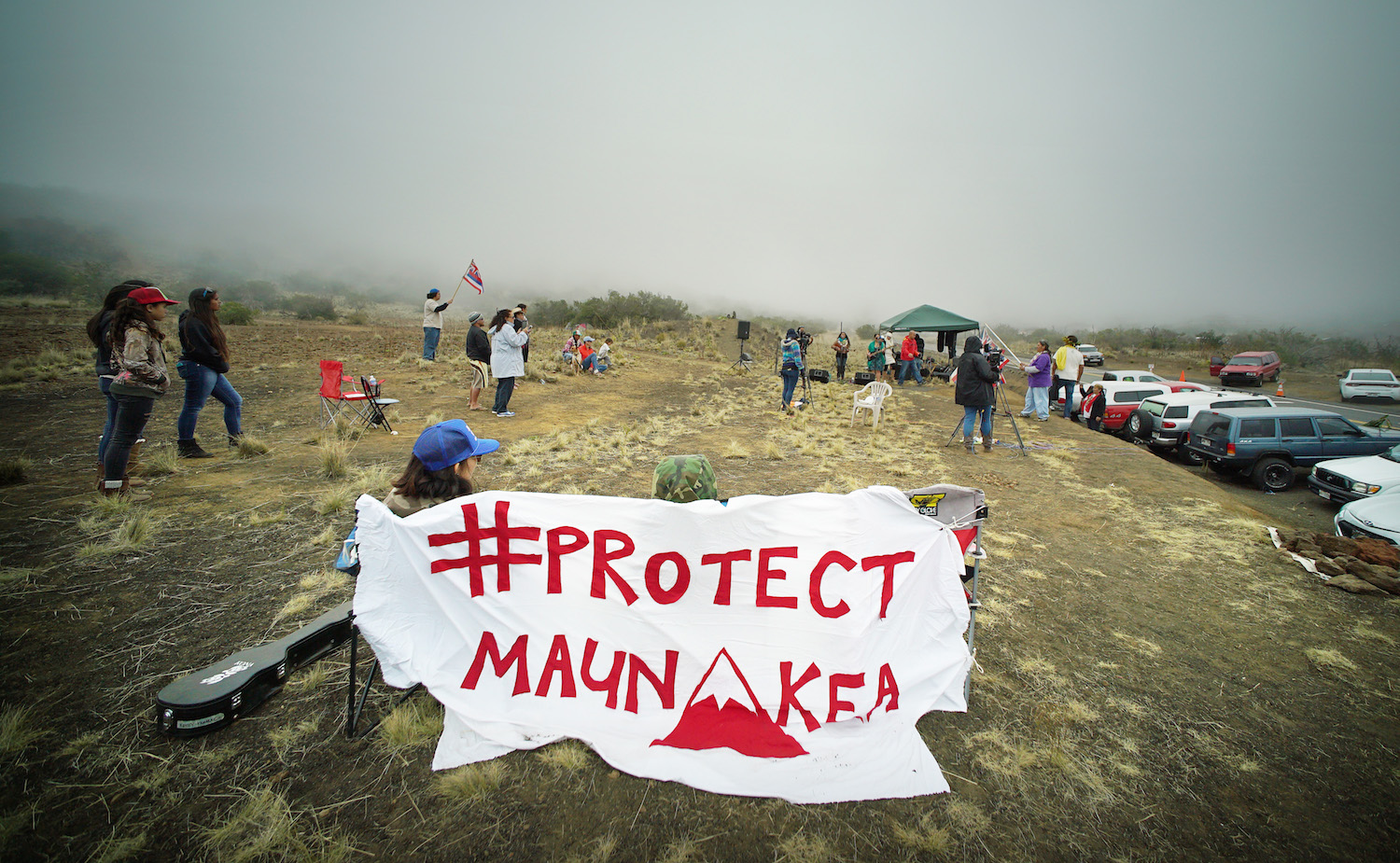Images courtesy of Cory Lum, Civil Beat
Standing at the rim of Kīlauea Caldera, reporter Jessica Terrell cannot see the molten lava that has been continuously erupting for the last 34 years. But she can hear it churn and gurgle beneath her feet as it flows through the volcano’s sunken magma chamber.
On this windy winter afternoon, Terrell has accompanied Pua Case, a Hawaiian cultural practitioner, to the home of Pele, the volcano deity, to ask for solidarity in the face of dissenting groups. Case is seeking strength in opposing the construction of the Thirty Meter Telescope on Maunakea, a 32,000-foot mountain on Hawaiʻi Island, where, according to Hawaiian spirituality, the gods dwell at the intersection of sky and summit. She is also asking for divine reinforcement in the resistance against other projects across the United States that call for things like pipelines or copper mines to be built on land and water considered sacrosanct by native peoples.
Terrell is the host of Offshore, a podcast produced by Honolulu news site Civil Beat and PRX, the nation’s largest public radio distribution marketplace. For it, she explores stories from Hawai‘i that offer insight into broader social issues playing out across the United States. In its inaugural season, Offshore charted the influence of racial unrest in two Honolulu killings set 80 years apart. The show’s current season investigates the clash between science and culture in the debate over the construction of the Thirty Meter Telescope, or TMT, on Maunakea. It also delves into a bid by Native Hawaiians to reclaim the meaning of aloha, and what happens when there are conflicting interests in lands that are culturally regarded as sacred, yet scientifically deemed to be the best in the world for astronomical exploration.

On her journey to tell the story of Hawai‘i’s tallest mountain, Terrell was invited to witness intimate, sometimes spiritual moments in places that her sources considered holy. While Maunakea is a sacred site to many Native Hawaiians, it is also viewed as a sort of interplanetary Eden by some astronomers, who revere the mountain as a gateway to ancient galaxies and billion-year-old stars. The conflict between preserving the sacred and seeing new intergalactic frontiers is complicated by the dozen other telescopes already littered across the mountain’s slope, as well as the treacherous history of land grabbing in Hawaiʻi.
The reporting process also took Terrell to Oak Flat, Arizona, to land that is considered sacred to Native Americans at the San Carlos Apache Indian Reservation. Located on top of one of the world’s largest copper deposits, the land is highly desired by an international mining corporation. In a rugged ravine dotted with petroglyphs, Terrell watched as masked Apache men wearing body paint and elaborate wooden slat headdresses performed a crown dance. According to Apache religion, the dance was given to the tribes by mountain spirits in order to facilitate healing.
No cameras or recording devices were permitted in the audience, which included members of other indigenous groups fighting their own land battles. As the Apache danced, members of the Standing Rock Sioux Tribe and the Navajo Nation stood strong and silent alongside.
“As a reporter, it’s not my job to make a judgment on who’s right or who’s wrong, or whether these are truly sacred spaces,” Terrell says. “But I don’t think you have to be a Christian or a Buddhist or a Native Hawaiian or an astronomer to appreciate being able to be there and experience the moments that other human beings feel
are sacred.”

Back at the edge of Kīlauea Caldera, Case stands to face a thick billow of smoke pouring into the sky from the depths of the crater. Set beside her on the bleak, lunar-like crust of earth that conceals the lava is a bundle of native plants and a nip of liquor. Case believes that when you ask Pele to take on a heavy burden, you should offer her a spot of gin to wash your request down.
Tucked in Case’s palm is coal, a remnant from a fire that burned at an encampment at the junction of the Missouri and Cannonball rivers near the Standing Rock Sioux Reservation. Case traveled there to protest the Dakota Access Pipeline alongside indigenous peoples from around the nation. Now, she raises her open hand above her head and lends her quivering alto to a Hawaiian chant. Gusts of wind push and pull at her dark, hip-length hair. Though Case cannot see Pele, she knows the deity is there—in the fiery pit of the volcano, and among the indigenous movements aiming to protect the sanctity of native lands.
To listen to season two of Offshore, visit offshorepodcast.com or subscribe on iTunes.

